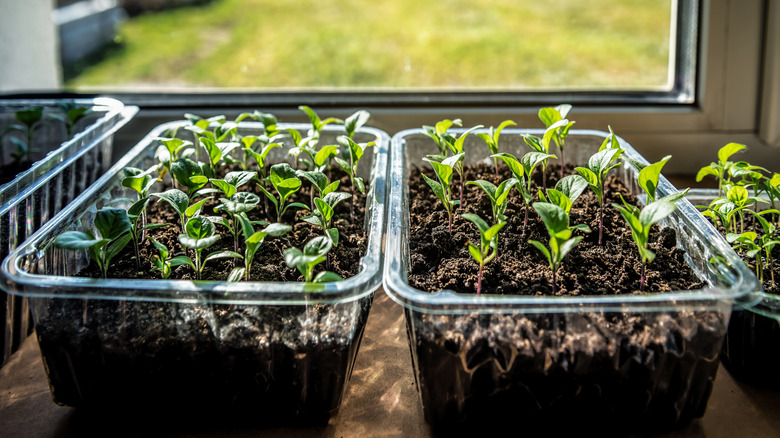Too Many Plastic Containers? Repurpose Them Into A Thriving Indoor Herb Garden
From carryout to leftover storage, the convenience of plastic food containers is undeniable. Considering how much plastic waste is created every year, it seems a shame to throw away containers that are missing a lid or have developed a minor flaw when they can be repurposed. Home cooks often think of herbs as seasonings, but they're packed with vitamins and polyphenols — compounds with antioxidant and anti-inflammatory qualities — and can be used in larger quantities than cooks might expect. Dishes like tabouleh, for example, call for a cup of parsley and a cup of mint. Think of how easy (and affordable) it would be to whip up those recipes when you have an herb garden in your kitchen. A sunny windowsill is the main prerequisite for using those containers to create an indoor herb garden. Growing these tasty and healthful greens indoors is easy, even for people who think they lack a green thumb.
Some herbs, like thyme (Thymus vulgaris), oregano (Origanum vulgare), and sage (Salvia officinalis), do better in containers than others. Herbs with extensive root systems, like fennel (Foeniculum vulgare) and horseradish (Amoracia rusticana), need more space than a normal plastic container can provide. If you don't have a windowsill that gets six hours of direct sun daily, you can supplement the light with 40-watt bulbs placed about a foot above the plants for 14 to 16 hours a day. After sunlight, herbs need good drainage, so you'll need to cut several holes in the base of the container. If you're worried that your windowsill could be damaged by overflowing containers, place them on a metal tray or set smaller containers in larger ones.
Using plastic containers to create an herb garden
Use a commercial potting soil or make your own with equal parts potting mix, perlite, and peat moss. Contrary to popular belief, you don't need to add a layer of pebbles to the bottom of the container to aid in drainage. In fact, this layer hinders the movement of water. Some herbs should be started from a seed instead of seedings, but most seedlings from the nursery or your own outdoor garden will thrive. You can plant a variety of herbs together in the same container if you use plants with similar water needs. Some, like oregano and rosemary (Salvia rosmarinus), prefer to dry out between irrigation. Others, such as basil (Ocimum basilicum) and dill (Anethum graveolens), need to stay moist. If you're worried about forgetting who needs what, make labels for the containers or keep a journal of what you've planted, which container it's in, whether it's an annual or perennial, its fertilization needs, and how often it needs watering.
Generally, you'll need to fertilize your indoor herb garden container garden because watering leaches nutrients out of the soil. Once the plants are established, you can harvest fresh herbs as needed, but don't let them go to flower because the flavor will diminish. If you find that your container garden is producing more herbs than you can use, tie the extras into bundles and let them dry in a warm, dry space or use everyday items to DIY an herb-growing rack. Colorful containers can be used to code which herbs are usually used in the same cuisine. Use green containers, for instance, to grow herbs frequently used in Italian cooking or plants used in teas in red containers.

